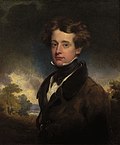Richard Rothwell (painter)

Richard Rothwell (20 November 1800 – 13 September 1868) was a nineteenth-century Irish
Biography
Richard Rothwell was born 20 November 1800 in Dublin. His father has generally been stated to be James Rothwell of Lisdaly, near Cloghen, King's Co. (Offaly), though primary source evidence suggests that he was the son of William Rothwell, gentleman, who appears in the 1820s as a publican of Ferbane, King’s Co., acquiring land at Ballicknahee, King’s Co. His mother was Elizabeth Rothwell (née Holmes). He had at least three siblings (a brother and two sisters) and possibly as many as six [3]. He trained to become a painter at the
In 1842 Rothwell married Rosa Marshall; the couple had several children.
In 1868, Rothwell contracted a fever while working in Rome and died. Joseph Severn, who painted a portrait of the Romantic poet John Keats, arranged for Rothwell's funeral and tomb in the Protestant Cemetery, Rome.[2]
Work
According to Fintan Cullen's biographical entry in the
Examples of his work
-
Mary Shelley (1840)
-
William Huskisson (1831)
-
Portrait of a young man
Notes
3. Devine, Ruth. "Rothwell, Richard". The Dictionary of Irish Biography.
Bibliography
- Cullen, Fintan. "Richard Rothwell". Oxford Dictionary of National Biography. Retrieved on 19 April 2008.
- Ormond, Lenoeé. "Richard Rothwell". Grove Dictionary of Art. Retrieved on 24 April 2008.
Devine, Ruth. "Rothwell, Richard". The Dictionary of Irish Biography. revised 2022.
External links
- An engraving by A. Duncan of
 The Rose of Edendale. in The Juvenile Forget Me Not, 1833 together with a poetical illustration 'The Rose of Eden-Dale and Her Hothouse Flowers' by Letitia Elizabeth Landon.
The Rose of Edendale. in The Juvenile Forget Me Not, 1833 together with a poetical illustration 'The Rose of Eden-Dale and Her Hothouse Flowers' by Letitia Elizabeth Landon.



